

To remove the application, open terminal and run the command: sudo pip3 uninstall WoeUSB-ng Then, run the command to create installer from iso image (run woeusb -h to get more options): sudo woeusb -device /PATH/TO/ISO /dev/sdbĪnd for BIOS boot, it’s better to add ‘–workaround-bios-boot-flag’ to workaround BIOS bug that won’t include the device in boot menu.

Running Linux without a desktop session? The tool also has command line options to do the job.įirstly, find out the USB stick device name (usually /dev/sdb) via command: sudo fdisk -l Plug the USB stick in target machine and select boot it in BIOS or UEFI, and enjoy! Create USB Windows Installer from command line


If everything goes OK, it should prompt “Installation Succeed” when done. It by default formats the drive into FAT, though you can select “NTFS” in options.Īfter clicking “Install” and confirm in pop-up dialog, it will open a new small dialog indicates the installing process. Then, launch WoeUSB-ng from start menu, select your ISO image or CD/DVD drive and highlight the USB stick (click “Refresh”) if not in list.īefore clicking the “Install” button, backup your data in the USB stick. Step 2: Create Windows USB Installer via WoeUSB-ngįirstly, you need to download the Windows ISO image or insert the CD/DVD drive, plug in your USB stick (8GB+ is recommended). Once installed, click the top-left “ Activities” button, then search for and open the tool: To do so, just run command: sudo pip3 install WoeUSB-ng Type user password for sudo authentication, though there’s no asterisk feedbackįor Fedora, run the command below instead: sudo dnf install git p7zip p7zip-plugins python3-pip python3-wxpython4 2.) Install WoeUSB-ngĪs a Python application, it’s easy to install via the pip package manager. When it opens, run the command below to install the dependencies: sudo apt install git p7zip-full python3-pip python3-wxgtk4.0 grub2-common grub-pc-bin Firstly, press Ctrl+Alt+T on keyboard to open terminal.


 0 kommentar(er)
0 kommentar(er)
